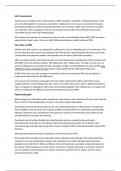Summary
Summary Accounting for inventory notes
- Course
- Institution
Presenting both an in-depth and light hearted discussion on the fundamentals of inventory valuation. Including but not limited to overhead allocation, fifo vs weighted average and periodic vs perpetual inventory systems. Primarily intended for beginner to intermediate level.
[Show more]






